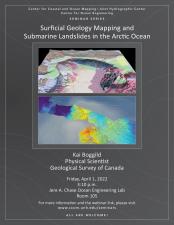Surficial Geology Mapping and Submarine Landslides in the Arctic Ocean
Geological Survey of Canada
For much of the 20th century, the thick perennial ice-cover of the central Arctic Ocean has limited access to ocean exploration. The first scientific icebreaker expeditions in the region began in the early 1990’s. Since then, international research efforts have combined for a multi-fold increase in the amount of high-resolution geophysical and geological data in the basin. There is now sufficient subbottom profiler, multibeam bathymetry and seafloor sample data in many areas to map the surficial geology of the seabed. In this talk, we present results of ongoing collaborative mapping efforts based on acoustic facies derived from internationally compiled subbottom profiler data. Mapped acoustic facies reveal the distribution of sedimentary processes that have left their mark on the seafloor in the high Arctic throughout the Quaternary. These include glacially eroded shelves and seafloor highs; deep-sea channel systems; contourite features and widespread submarine landslides. Some of these submarine landslides are prodigious in scale, covering extensive areas and involving thousands of cubic kilometers of material. Detailed mapping of two such large submarine landslides located in the southern Canada Basin of the Arctic Ocean suggest they are late-Holocene aged and derived from the Alaska-Beaufort slope. Slope stability along this part of the margin may be affected by a variety of preconditioning factors, including possible gas hydrate dissociation and fluid flow. Initial triggering of slope failure may be related to seismicity associated with ongoing deformation of the margin, or infrequent seismicity of the MacKenzie Thrust. These results reveal new insights into the sedimentary processes and depositional patterns in the basin.
Kai Boggild is a Physical Scientist with the Geological Survey of Canada (Atlantic) in Dartmouth, Nova Scotia, Canada. His background is in seafloor mapping, submarine geomorphology and interpretation of seismic data. He has participated in research cruises both on the Atlantic margin and in the Arctic, where his research focuses on the near-seabed geology and mass movements involving submarine landslides and turbidity currents. He is fascinated by deep-sea processes and always inspired by the surprising things we find when we map the seafloor.





